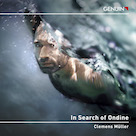

Clemens Müller: In Search of Ondine
GENUIN classics
As one might expect from a piano album whose contents span six centuries (the sixteenth to the twenty-first, to be exact), Clemens Müller's In Search of Ondine is an expansive travelogue abundant in contrasts of mood and style. Unifying this digital release is the concept the Tuebingen-born pianist adopted to guide his curatorial choices, specifically works that draw for inspiration from the familiar fairy tale about the water nymph (or mermaid) who falls for a human. The earliest piece, a vibrant, Baroque-styled reverie by Dutch composer Jan Sweelinck, is so old it even predates the piano, while the most recent was finished mere days before the recording occurred. Adding to the release's value is the inclusion of world premiere recordings to augment ones by Ravel, Debussy, and Schubert that by comparison are well-established. Augmenting material by J. S. Bach, Rubinstein, Schulhoff, Schönthal, Medtner, Chaminade, Liszt, Einaudi, Crumb, Couperin, and Richard Strauss are pieces by the young composers Shadi Kassaee and Leander Ruprecht, both born in 1999.
Also helping to impart cohesiveness to the project are three treatments of the psalm “By the Waters of Babylon” by Bach, Charles-Valentin Alkan, and Kassaee, with each presenting a fascinatingly different response to the hymn's expression of lament and longing. In Search of Ondine begins, however, with Strauss's “An einsamer Quelle” from 1903's Stimmungsbilder, an instantly entrancing romantic expression whose rhapsodic lilt suggests the poetic flow of waves. From 1853, Schulhoff's L'Ondine follows, its sparkling character consistent with its title and realized resplendently by Mueller, who currently teaches piano at the Trossingen University of Music. Exemplifying characteristic French Baroque elegance is “Les Ondes” from Couperin's1713 work Premier Livre de Pièces de Clavecin, Cinquième Ordre. From Crumb's second Makrokosmos volume (1973) comes “Rain-Death Variations (Pisces),” one of the work's twenty-four “fantasy-pieces” and emblematic of material distinguished by daring explorations of musical texture, timbre, and resonance.
Ravel's represented by “Ondine,” the dream-like opening movement from 1909's Gaspard de la Nuit and whose shimmering cascades and declamatory flourishes evoke the fantastical aura of the water nymph tale. It's tempting to hear Debussy's “Ondine” (from his second book of Préludes) as a response to Ravel when it followed his same-titled setting by four years, even if Debussy's is the more mischievous and mysterious of the two. Speaking of dream-like, Muller's sensitive renderings of Medtner's “Gesang der Wassernymphe” (from 1926's Improvisation No. 2) and Chaminade's L'Ondine (from 1900) amplify their delicate and rhapsodic qualities. From 1883's Années de pèlerinage III, S. 163, Liszt's “Les jeux d'eaux à la Villa d'èEste” transports the listener to the Tivoli locale with glittering melodies as ravishing as they are serene. Also intoxicating is “Lontano,” the third of thirteen parts that make up Einaudi's Le Onde (1996), which seduces with a gentle, song-like rapture and undulating feel. Muller's touch and pacing do much to maximize the material's impact, and much the same could be said about his handling of Anton Rubinstein's sweeping Ondine (1843).
With respect to the psalm, Bach's An Wasserflüssen Babylon, BWV 267 (1735) is marked by lyrical eloquence; Alkan's 1859 treatment, Super flumina Babylonis, Op. 52 (An Wasserflüssen Babylon), retains the formal elegance of Bach's but explores a broader range of moods, from introspection to aggression and grandeur. Kassaee's Rudhaye Babel (An Wasserflüssen Babylon) (2024) by comparison opts for a knottier landscape sprinkled with chromatic gestures, prickly textures, and prepared piano flourishes. Another outlier is Ruprecht's Eine Handvoll Wasser, which disrupts the general mood of peaceful splendour with crashing chords and bold, nachtmusik-like gestures. Countering such statements is the rhapsodic “Am Meer” from Schubert's Schwanengesang, D 957 (1829), a collection of fourteen songs written near the end of his life and published posthumously. How fitting that an album project grounded in a fairy tale concept should resolve with a piece that's more reverie-inducing than nerves-fraying.March 2025